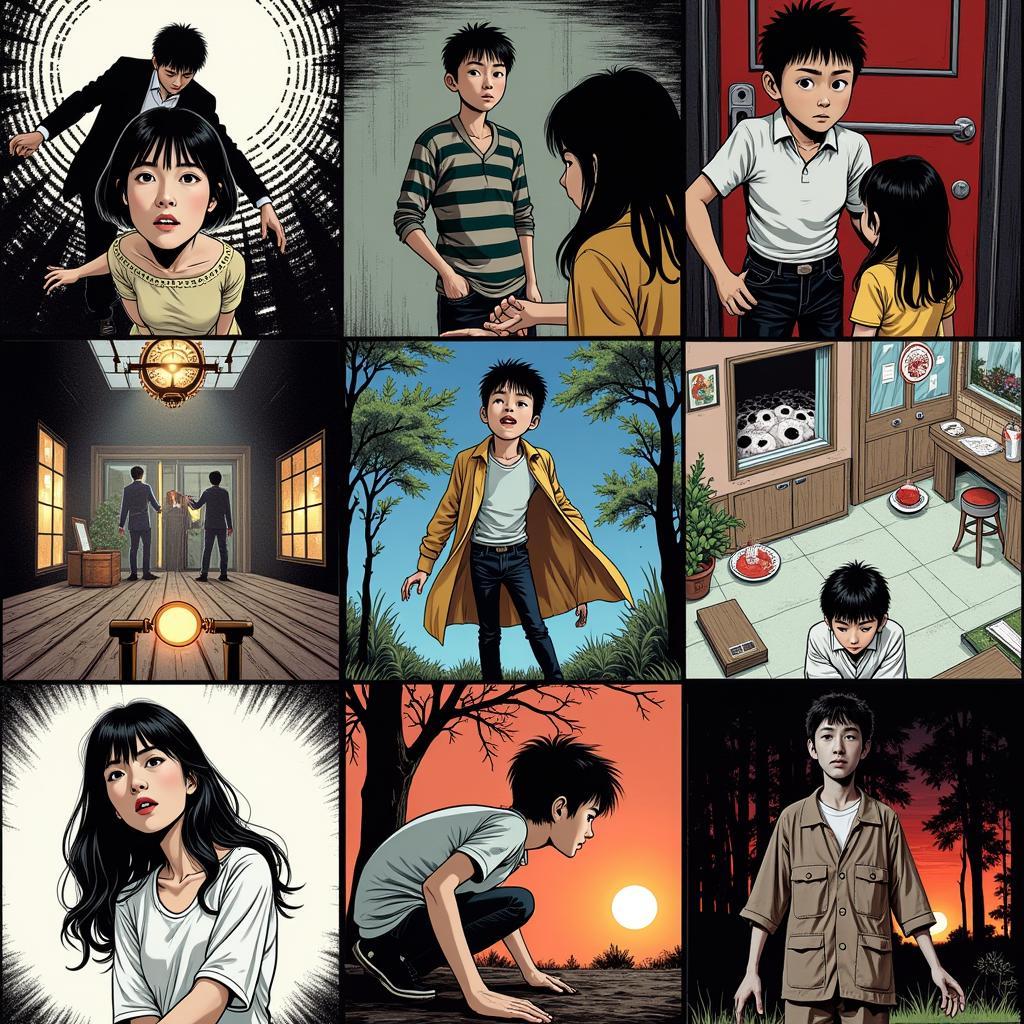Delving into the Disturbing World of Junji Ito Horror Art
Junji Ito Horror Art has captivated and disturbed audiences worldwide with its grotesque imagery and psychological depth. From spiraling snails to unsettling human transformations, Ito’s work explores the darkest corners of the human psyche and the uncanny nature of reality. His distinct style, characterized by meticulous detail and a fascination with the macabre, has cemented his place as a master of horror manga and a significant influence on contemporary horror art. Let’s explore the unsettling beauty and profound impact of Junji Ito’s creations.
The Unique Style of Junji Ito’s Horror
Ito’s work stands out due to his incredibly detailed and realistic art style, which he uses to depict incredibly surreal and disturbing scenarios. This juxtaposition of the real and the unreal creates a sense of unease that permeates his work. He often focuses on body horror, transforming familiar human forms into grotesque and unsettling figures. This transformation, often gradual and meticulously depicted, allows the horror to seep into the reader’s mind, creating a lasting sense of dread. He masterfully builds suspense, often starting with seemingly mundane situations that slowly descend into nightmarish realities.
One of the first things you’ll notice in any Ito piece is his meticulous linework. It’s incredibly precise and detailed, almost obsessively so. This detail brings a sense of realism to his grotesque creations, making them all the more unsettling. Check out some of the horror art books available online for a closer look at his detailed work.
Exploring Common Themes in Junji Ito Horror Art
Recurring themes in Ito’s work include the fragility of the human body, the fear of the unknown, and the unsettling aspects of everyday life. He often explores the idea of obsession, showcasing how a singular focus can warp perception and lead to devastating consequences. The theme of transformation is central to many of his stories, with characters undergoing physical and psychological changes that reflect their inner turmoil and the corrupting influence of the supernatural. These transformations are not always monstrous; sometimes, they are subtle shifts in behavior or appearance, adding to the psychological depth of his narratives. He also delves into cosmic horror, presenting vast and incomprehensible forces that dwarf humanity and challenge our understanding of the universe.
One particularly striking theme is the juxtaposition of beauty and horror. Ito often depicts grotesque imagery with a strange sense of beauty, blurring the lines between attraction and repulsion. This unsettling aesthetic contributes to the unique and disturbing atmosphere of his work.
The Influence of Junji Ito on Contemporary Horror
Junji Ito’s influence can be seen in various forms of media, from film and television to video games and other visual arts. His distinct style and thematic concerns have inspired countless artists and creators, contributing to a resurgence of interest in body horror and psychological thriller narratives. His ability to tap into primal fears and explore the darker aspects of human nature has resonated with audiences worldwide, establishing him as a true icon of horror.
“Ito’s ability to blend the mundane with the monstrous is what truly makes his work so effective,” says Dr. Emily Carter, a leading expert in horror literature. “He takes everyday anxieties and amplifies them to nightmarish proportions, forcing us to confront the unsettling truths that lie beneath the surface of reality.”
 Influence of Junji Ito on Contemporary Horror
Influence of Junji Ito on Contemporary Horror
Getting Started with Junji Ito: Essential Reads
For those new to Junji Ito’s work, starting with some of his most acclaimed stories is recommended. Uzumaki, a chilling tale of a town obsessed with spirals, is a classic example of Ito’s masterful storytelling and disturbing imagery. Gyo, featuring grotesque fish with legs, is another popular choice, showcasing his ability to blend body horror with environmental themes. The Enigma of Amigara Fault, a short story about irresistible human-shaped holes in a mountainside, is a perfect introduction to his unsettling and thought-provoking style. For those interested in a comprehensive collection of his work, exploring resources like the art of horror book can be a great starting point.
Conclusion: The Enduring Appeal of Junji Ito Horror Art
Junji Ito’s horror art continues to fascinate and disturb audiences with its unique blend of grotesque imagery, psychological depth, and masterful storytelling. His exploration of the darkest corners of the human psyche and the uncanny nature of reality has cemented his place as a master of the genre. From the unsettling beauty of his meticulously detailed artwork to the thought-provoking themes he explores, Junji Ito’s work offers a chilling and unforgettable journey into the heart of horror.
FAQ
-
What is Junji Ito known for? Junji Ito is renowned for his horror manga, characterized by grotesque imagery, psychological depth, and a distinct artistic style.
-
Where can I read Junji Ito’s work? His manga is available in print and digital formats from various publishers and online platforms.
-
What are some of Junji Ito’s most popular works? Uzumaki, Gyo, The Enigma of Amigara Fault, and Tomie are among his most acclaimed stories.
-
What themes does Junji Ito explore in his work? Common themes include body horror, the fear of the unknown, obsession, transformation, and cosmic horror.
-
Has Junji Ito’s work been adapted into other media? Yes, his stories have inspired films, television shows, video games, and other artistic creations.
-
What makes Junji Ito’s art style so unique? His meticulous linework and realistic rendering of grotesque imagery create an unsettling and unforgettable aesthetic.
-
Why is Junji Ito considered a master of horror? His ability to tap into primal fears, explore the darker aspects of human nature, and create truly disturbing narratives has earned him this recognition.
“Ito’s work stays with you long after you’ve finished reading,” adds Professor Kenji Tanaka, a cultural critic specializing in Japanese horror. “It’s a testament to his skill as a storyteller and his ability to evoke a deep sense of unease.”
Need more assistance? Contact us at Phone: 02462573573, Email: danteum@gmail.com or visit us at Savico Megamall, 7-9 Đ. Nguyễn Văn Linh, Gia Thụy, Long Biên, Hà Nội 10000, Việt Nam. We have a 24/7 customer service team.


